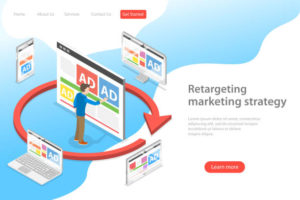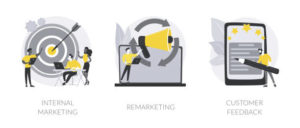What is Retargeting in Digital Marketing and How it Work? Retargeting is one of the most effective and cost-efficient ways to attract customers. It targets individuals who previously visited your website or purchased a product.
It can be very effective when combined with KPIs (key performance indicators) and allows you to control your spend and bids based on the type of campaign. You can even measure your success by tracking your click-through rate, conversion rate, and other key metrics. Retargeting in Digital Marketing
Site retargeting
The most common form of retargeting is called pixel-based. Pixels are small pieces of code that re-displays content to anonymous visitors. These ads are served to users based on their browsing history. If someone visits your website, the pixel will drop an anonymous browser cookie that tells the retargeting provider when to serve them ads.
By placing a tracking pixel on the website, your website can become more relevant to visitors. Retargeting is a powerful tool for digital marketers. It reduces the cart abandonment rate by up to 6.5% and can increase sales and conversions.
Clever marketers leverage the power of retargeting campaigns to remind website visitors of the products and services that they may have once looked at
For example, a fashion retail chain in Europe saw a 66% increase in conversion rates after using retargeting ads. Retargeting works well for a variety of different situations. For example, if a customer leaves a shopping cart but later returns to the site, retargeting ads are a great way to remind them of the products they left behind.
Depending on the type of product, retargeting ads may even prompt a customer to upgrade from a free trial. This method is effective for a variety of purposes and is highly cost-effective.
Aside from being highly effective, site retargeting also has several drawbacks
When used too often, retargeting ads may annoy a customer. They may even unsubscribe or block their ads altogether. In this case, a user might want to find out the best gas and electricity rates, and a pixel tags him for visiting the website.
The next time he performs the same search, he will be shown ads for different gas and electricity companies. AGL ads will appear on various websites and on various social media channels.
Site retargeting works best when used with demand generation, inbound marketing, and other strategies
Although retargeting alone cannot drive traffic, it can dramatically increase conversions. To be effective, however, retargeting should be a part of your overall marketing strategy. You should carefully evaluate your objectives and budget before launching a retargeting campaign.
It is crucial to measure the effectiveness of each campaign to make the most of this powerful technique. Retargeting campaigns are highly effective at reminding customers of products and services they may have already purchased. The technology is a powerful tool, and it works across platforms, including Google Ads, Facebook retargeting, LinkedIn ads, and more.

Those who are serious about their business will utilize retargeting in their digital marketing campaigns
It helps build brand awareness and increases sales. So, what is site retargeting in Digital Marketing? Site retargeting allows businesses to retarget visitors to their website after they’ve left their site. It allows businesses to keep their brand front and center and brings back window shoppers when they’re ready to make a purchase.
It is an effective way to keep your brand in front of customers and improve brand recognition. A high click-through rate and high conversions are two key benefits of site retargeting.
List-based retargeting
Retargeting is an effective way to convert website visitors into paying customers. However, it does have some drawbacks. List-based retargeting requires a list, so it is less automatic than pixel-based retargeting. While both methods can work well, there are important differences between them.
Here’s a breakdown of the advantages and disadvantages of each. You should use list-based retargeting if your business has a comprehensive list of customers.
This type of retargeting uses email addresses to display advertisements to visitors
Because of its targeted nature, it allows marketers to send personalized emails to the people who have visited their website. These emails are also ideal for awareness campaigns, which remind visitors of relevant products and encourage them to go further down the sales funnel.
Aside from conversion, list-based retargeting also allows businesses to track the behavior of a targeted audience. A major disadvantage of list-based retargeting is the low match rate. This method relies on an email address to sync users.
However, it is possible to use inbound content to fuel retargeting activities
Various social media platforms have their own native retargeting tools. In addition, third-party platforms like Facebook and Google offer web retargeting. Ultimately, list-based retargeting is a powerful way to engage your customers.
Using retargeting is an excellent way to draw a repeat customer. In fact, nearly 70 percent of U.S. adults use at least one social network, such as Facebook and Twitter. Retargeting allows marketers to continue targeting visitors through various platforms.
There are list-based and pixel-based retargeting services
For more information, check out our retargeting services article! When using list-based retargeting in digital marketing, make sure you choose a timeframe for the ads. You should know when a visitor last visited your website and how often they accessed the content on the site.
Remember that these groups may not respond to ads at all if you keep sending them emails about the same products. Retargeting based on known behaviors will increase your chances of conversion.
One advantage of list-based retargeting in digital marketing is that it allows advertisers to create lists based on user behavior
For example, an online flower shop might want to increase its bids for users who visited their website around Valentine’s Day or other specific dates. In this case, a RLSA can create lists based on users’ page visits on those dates. Because the list is only valid for 180 days.

Advertisers should reduce their bids for audiences that are not highly valuable to their business
List-based retargeting in digital advertising is a highly effective way to target people who visited your website but left the site.
This type of remarketing helps you keep your brand top-of-mind by reminding inactive users of your app, introducing them to new products, and introducing them to the latest features. This way, you can increase your conversion rate significantly. It also increases engagement and retention.
AdRoll retargeting
Retargeting is one of the best ways to generate more online sales and increase brand recognition, but 97% of visitors don’t buy on their first visit. With AdRoll Retargeting, marketers can target visitors and promote products in ways that make them return.
The platform allows advertisers to target customers across different digital media, including display networks, social networks, and native apps. Users can choose which ads they want to see, and AdRoll retargeting automatically rebuilds orders when a visitor clicks on them.
The process of using AdRoll is relatively simple
The platform will sync your lists from HubSpot and AdRoll, giving you the advantage of multiple ad formats. AdRoll also has a simple one-page form to request various ad formats. You can even request a particular percentage of conversions that result from each ad format.
By implementing AdRoll retargeting in your digital marketing campaigns, you will stay top of mind with your customers.
With the help of AdRoll, you can reach your customers across different platforms, from mobile phones to desktops
They also offer access to more than 500 ad exchanges, including native inventory such as Facebook, Instagram, and Google. Besides the variety of ad networks, AdRoll also has advanced tools that will help you achieve your marketing goals. The AdRoll dashboard lets you monitor your campaigns across multiple platforms and retargeting capabilities. For Home page click here

